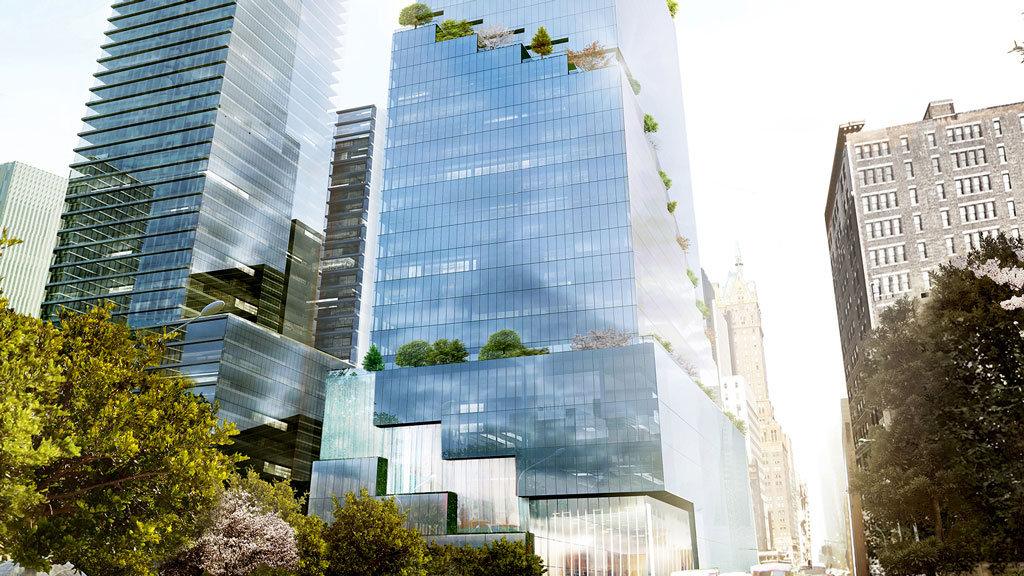Former mayor Ed Koch said it best: “New York is where the future comes to audition.”
Two new buildings that opened this year illustrate his point.
One is an all-electric residential tower that seeks to optimize the occupant living experience in combination with zero emissions. The other is a commercial office tower that embraces the modern hybrid work model. Both are tall; it’s New York City after all.
More importantly, their individual pursuit of unique objectives sets high levels of expectations for future buildings.
505 State Street, a 44-storey residential tower in Brooklyn, was designed and developed by . Through a partnership agreement with Con Edison, locally-generated solar energy will be the building’s primary electricity source.
Going all-electric is timely. New York City Local Law 97, passed in 2019, requires buildings over 25,000 square feet to reduce carbon emissions by 40 per cent by 2030, and by 80 per cent by 2040. Specifically targeted items are gas appliances and furnaces. Although a lawsuit challenging Local Law 97 has been allowed to continue, the message to address carbons will not be lost on those planning major new projects in the future.
Jared Della Valle, CEO of Alloy Development, told tech publication that going all-electric was not as difficult as first imagined.
“The best way to achieve sustainable outcomes or efficiency outcomes is through high performance building envelopes,” he said.
Less air conditioning and heating demand in turn lowers energy demand. Systems for both can then be reduced in size.
“It’s really not that complicated at the end of the day.”
As far as gas appliances like stoves are concerned, Della Valle said contemporary cooking preferences are already moving towards electric devices like induction cooktops, making the elimination of gas stoves acceptable to tenants.
There’s more to 505 State Street than its energy source.
A housing lottery was held for 45 of its 440 units that were set aside for those with vision, hearing and mobility issues as well as for those with lower incomes. For example, peak at $1,150 for a three-bedroom unit for those earning only 40 per cent of the area’s median income. The for the same three-bedroom unit is currently $11,250 per month.
All units have exposed concrete interior walls and columns, oak flooring and 7.5-foot-high triple pane windows. All tenants share amenities like a rooftop pool and terrace, a 3,000-square-foot gym and a “grow room greenhouse” filled with plants.
Alloy 505 State is, “designed to bring out the best in us and make every moment better. Every apartment is delivered with liveability in mind.”
In Manhattan, at the north end of the High Line, the Spiral soars 1,031 feet. It was designed for New York-based multi-national property investment firm by the Bjarke Ingels Group, a design firm with offices across North America and Europe.
The Spiral’s LEED Gold-certified design features a “ziggurat silhouette” in the form of stepped spiral terraces that span the exterior. Each floor opens to outdoor hanging gardens featuring drought-resistant plants, shrubs and ivy, an overall garden space of 13,000 square feet. An interior cascading atria connects the open floor plates from the ground floor to the summit in a single uninterrupted workspace.
“The Spiral’s interior design draws inspiration from nature, creating a calming and rejuvenating environment,” its . “With sweeping views of the city and the Hudson River and seamless connections to exterior terraces on every floor, the property provides a connection to the outdoors that is rare in a modern urban setting.”
The 2.8 million square feet of leasable office and private event space might seem counterintuitive at a time when many companies are reducing their commercial footprints. However, Tishman Speyer CEO Rob Speyer believes the Spiral actually addresses the modern workplace.
In an interview with the , Speyer explained the collaborative work environment that has been included in the design of the Spiral. He calls these areas of flexible work space Spiral’s “Studio Space” product. They range from a one-person “Phone Booth” available for $25/hour, to meeting rooms and offices for up to 10 people at $300/hour.
“Projects like the Spiral are benefiting right now disproportionately, buildings where the owner has been intentional and purposeful about creating a collaborative environment,” he said.
As an example, international bank and investment firm HSBC announced it will lease 265,000 square feet of space in the Spiral. While that represents a 50 per cent reduction over their previous footprint, Speyer explained HSBC was attracted to the building’s two floors of short-term, rentable co-working space adjacent to their fixed space, giving them the possibility to expand in a flexible manner over time.
These two bold buildings each make powerful statements about the future of large urban projects.




Recent Comments
comments for this post are closed